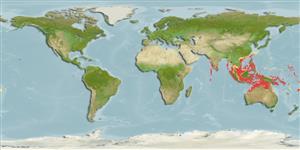>
Eupercaria/misc (Various families in series Eupercaria) >
Lutjanidae (Snappers) > Lutjaninae
Etymology: Pinjalo: A Malay word, pinialo, for a fish; lewisi: Named for Anthony Lewis..
More on authors: Randall, Allen & Anderson.
Environment: milieu / climate zone / depth range / distribution range
Ökologie
seewasser riff-verbunden; tiefenbereich 20 - 150 m (Ref. 9821). Tropical; 32°N - 20°S, 72°E - 178°W
Indo-Pacific: Laccadive Islands to Fiji, north to the Ryukyu Islands.
Size / Gewicht / Alter
Maturity: Lm ? range ? - ? cm
Max length : 50.0 cm SL Männchen/unbestimmt; (Ref. 48635)
Rückenflossenstacheln (insgesamt): 12; Rückenflossenweichstrahlen (insgesamt): 13; Afterflossenstacheln 3; Afterflossenweichstrahlen: 8 - 9.
Often form schools (Ref. 90102). Inhabit reefs and rocky bottoms. They feed on benthic and planktonic invertebrates and possibly small fishes. Marketed fresh or dried-salted.
Life cycle and mating behavior
Geschlechtsreife | Fortpflanzung | Ablaichen | Eier | Fecundity | Larven
Randall, J.E., G.R. Allen and W.D. Anderson Jr., 1987. Revision of the Indo-Pacific lutjanid genus Pinjalo, with description of a new species. Indo-Pac. Fish. (14):17 p. (Ref. 6177)
IUCN Rote Liste Status (Ref. 130435)
Bedrohung für Menschen
Harmless
Nutzung durch Menschen
Fischereien: weniger kommerziell
Mehr Information
NamenSynonymeMetabolismusRäuberÖkotoxikologieFortpflanzungGeschlechtsreifeAblaichenSpawning aggregationFecundityEierEientwicklung
ReferenzenAquakulturAquakultur ProfilZuchtlinienGenetikElectrophoresesVererbbarkeitKrankheitenVerarbeitungNutrientsMass conversion
PartnerBilderStamps, Coins Misc.LauteCiguateraGeschwindigkeitSchwimmstilKiemenoberflächeOtolithsGehirngrößeSehfähigkeit
Tools
Zusatzinformationen
Download XML
Internet Quellen
Estimates based on models
Preferred temperature (Ref.
123201): 21.7 - 27.9, mean 26.4 °C (based on 376 cells).
Phylogenetic diversity index (Ref.
82804): PD
50 = 0.7500 [Uniqueness, from 0.5 = low to 2.0 = high].
Bayesian length-weight: a=0.01479 (0.00709 - 0.03087), b=2.97 (2.80 - 3.14), in cm total length, based on LWR estimates for this (Sub)family-body shape (Ref.
93245).
Trophic level (Ref.
69278): 3.3 ±0.38 se; based on food items.
Widerstandsfähigkeit (Ref.
120179): mittel, Verdopplung der Population dauert 1,4 - 4,4 Jahre. (Preliminary K or Fecundity.).
Fishing Vulnerability (Ref.
59153): Moderate vulnerability (44 of 100).
